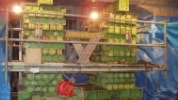Corporate Information History

Major Events
We have grown by proactively adopting reforms and
improvements that meet the needs of the times.
1800
1908 MIYAJI IRON WORKS began operations
Kurogane Bridge
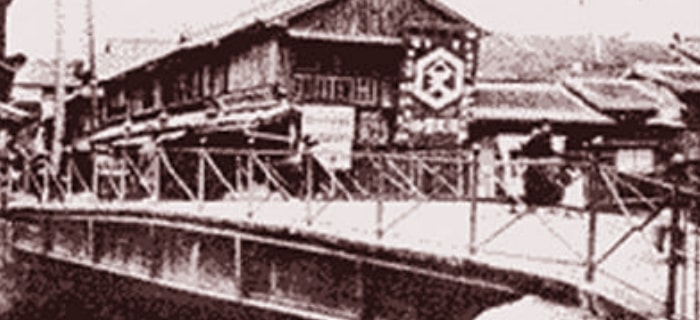
|
1800 |
1868 Construction of Kurogane Bridge,  Japan’s first steel bridge |
1883 |
1884 |
1908 MIYAJI IRON WORKS began operations 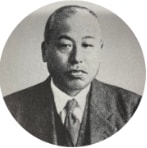 |
|
<MIYAJI IRON WORKS began operations> |
||||
|
Nationally-operated Nagasaki Seitetsusho ironworks established. |
Name changed to Ministry of Industry Nagasaki Shipyard. |
Merged with Yubin Kisen Mitsubishi Kaisha (the year when Mitsubishi Heavy Industries, Ltd. was founded). |
1910~30
1919 Started bridge construction business.
Great Kanto Earthquake
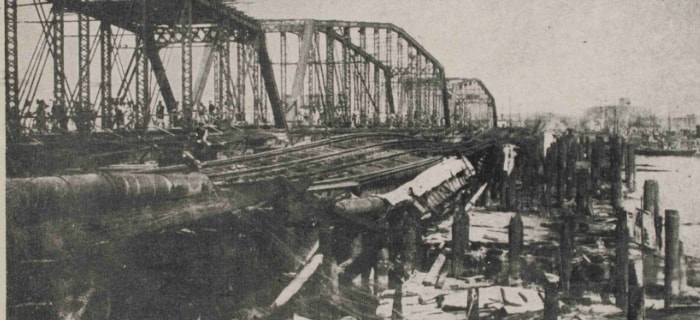
|
1910 |
1919 |
1920 1923 Great Kanto Earthquake  |
1924 |
1928 |
1930 1931 |
1934 |
1937 |
1938 |
|
Ojima Works opened in Ojima-machi, Minami-Katsushika, Tokyo. Bridge construction began from following year. |
Minami-Futaba-cho Office and Ojima Works completely destroyed in fire. Company reorganized as MIYAJI IRON WORKS limited partnership company following the Great Kanto Earthquake with \50,000 in capital stock. |
Minami-Futaba-cho Office and Ojima Works rebuilt. Company received large volume of orders for railway bridge construction due to damage from the earthquake. |
Ojima Works expanded. |
Head Office building and plant constructed in Minami-Suna-machi, Joto-ku. Minami-Futaba-cho Office and Ojima Works closed. |
Keijo Office opened. |
Company reorganized as joint-stock corporation with \500,000 in capital stock. |
||
|
Company name changed to Mitsubishi Heavy Industries, Ltd. |
1940~50
1945 Matsumoto Works (Hata Works) opened
1949 MIYAJI CONSTRUCTION & ENGINEERING spun off as independent company
Tokyo Tower completed
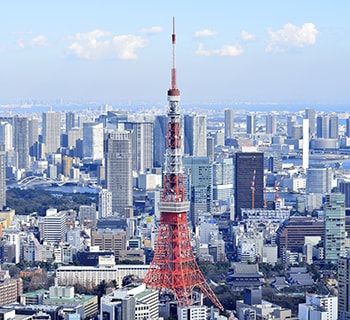
|
1940 |
1942 |
1945 Matsumoto Works (Hata Works) opened Tokyo Air Raid |
1946 |
1949 
MIYAJI CONSTRUCTION & ENGINEERING spun off as independent company |
1950 1950 |
1952 |
1954 |
1955 |
1958 Tokyo Tower completed 
|
1959 |
|
Designated as a Navy-managed plant, took part in establishment of Tokyo Shipbuilding Works, Ltd. |
<Matsumoto Works (Hata Works) opened> |
Hata Works began operations, Tokyo labor union formed. |
Registered with Minister of Construction following enactment of Construction Business Act. |
Suna-machi No. 2 Works (temporary assembly) began operations. |
Engineer Training Center opened. |
Head Office building completed (Suna-machi). |
Marked 50th anniversary of company’s foundation. |
Fukuoka Sales Office opened. |
||
|
<MIYAJI CONSTRUCTION & ENGINEERING spun off as independent company> Registered with Minister of Construction following enactment of Construction Business Act. |
Head Office relocated to Bunkyo-ku, Tokyo. |
|||||||||
|
Company split into West Japan Heavy-Industries, Ltd., Central Japan Heavy-Industries, Ltd., and East Japan Heavy-Industries, Ltd. with the dissolution of the zaibatsu conglomerates (the year when Mitsubishi Heavy Industries, Ltd. was established). |
Names of three heavy industries companies changed to Mitsubishi Shipbuilding & Engineering Co., Ltd., Shin Mitsubishi Heavy-Industries, Ltd., and Mitsubishi Nippon Heavy-Industries, Ltd. |
1960
1963 Suna-machi No. 1, No. 2, and No. 3 Works completed
Edobashi Junction
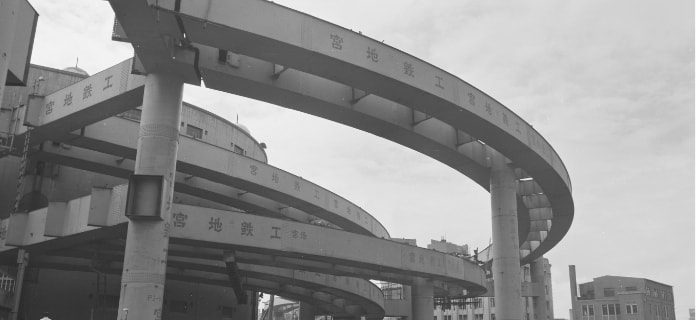
|
1960 |
1961 |
1962 |
1963 Suna-machi No. 1, No. 2, and No. 3 Works completed 
Edobashi Junction opened |
1964 Tokaido Shinkansen Tokyo to Shin-Osaka section opened |
1964 
1966 Maya Bridge opened 
1968 Aki Bridge opened |
1969 |
|
Hata Works renamed Matsumoto Works. |
Listed on the 1st Section of Tokyo Stock Exchange. |
<Suna-machi No. 1, No. 2, and No. 3 Works completed> Omiya Warehouse opened. |
Capital increased (\1,000 million). |
New general office and Matsumoto West Works completed and designated as Japanese National Railways “quality management method” plant. |
||
|
Capital increased (\30 million). |
Kurihashi Warehouse (now Kurihashi Equipment Center) opened. |
Listed on the 2nd Section of the Tokyo Stock Exchange. |
||||
|
Three heavy industries companies merged and company name changed to Mitsubishi Heavy Industries, Ltd. |
1970
1972
Acquired land for construction of Fukuyama Works/Began pier construction
1975
Dramatic personnel reduction through reorganization
Kanmon Bridge
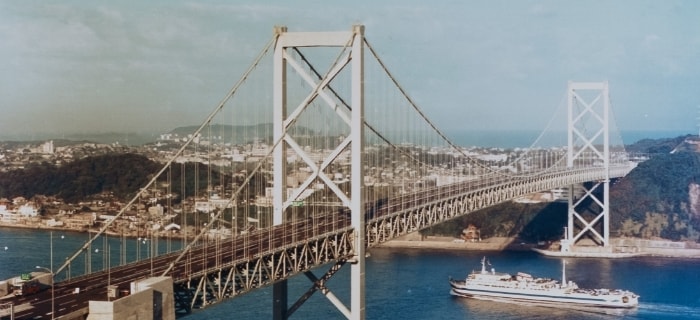
|
1970 |
1970 |
1971 |
1972 Acquired land for the Fukuyama Plant / Performed quay wall construction The first oil shock MHI Construction, the predecessor of MMB, was established as a wholly owned subsidiary of Mitsubihi Heavy Industries. 
1973 Kanmon Bridge opened |
1974 
Minato Bridge opened |
1975 Dramatic personnel reduction through reorganization |
1976 |
1977 |
1978 |
|
Decided to introduce the use of computers (the Burroughs B-2500) from 1971. |
New Technology Building (six-story building) completed. |
Business collaboration with Nippon Kokan. Technical Training Center closed. |
Ichikawa Works (temporary assembly and painting works) opened. |
<Dramatic personnel reduction through reorganization> |
No. 3 Works closed, equipment added to Ichikawa Works, Fukuyama Works grounds returned to Hiroshima Prefecture. |
Sendai Sales Office opened. |
||
|
Guam Thermal Power Plant Construction Project launched. |
Received special construction business license under the Construction Business Act. |
Head Office sold. |
Head Office relocated to Koto-ku, Tokyo. |
|||||
|
Mitsubishi Heavy Industries Construction Co., Ltd. established as a wholly-owned subsidiary of Mitsubishi Heavy Industries, Ltd. |
||||||||
1980
1983 Large seaside plant (Chiba Works) opened
1984 Rokugo Bridge accident
Yokohama Bay Bridge
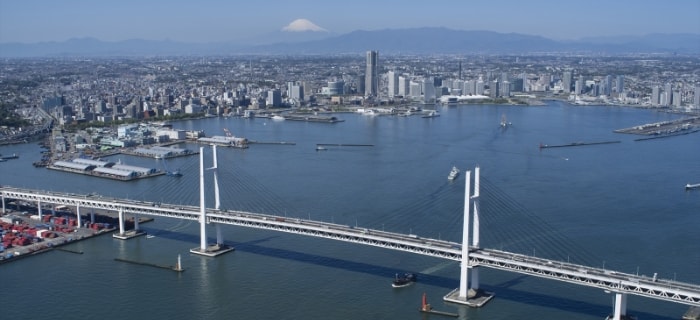
|
1980 |
1980 The second oil shock |
1981 |
1983 Large seaside plant (Chiba Works) opened |
1984 Rokugo Bridge accident |
1985 |
1986 
Ohnaruto Bridge opened |
1987 Black Monday |
1988 
Seto-Ohashi Bridges opened |
1989 
Yokohama Bay Bridge opened |
|
All shares acquired by Seibi Group (Highest share price: \2,950). Chairman Sakurai and Senior Managing Director Saka appointed at Extraordinary General Meeting of Shareholders. |
Capital increased (\3,000 million). |
Head Office relocated to Chuo-ku, Tokyo. |
Matsumoto Works given Grade S Steel Frame Production certification. |
Rotated employees from Matsumoto (second phase: 24 members). |
Marked 80th anniversary of company’s foundation. |
Shojukai established. |
|||
Head Office relocated to Toshima-ku, Tokyo. |
Purchased shares of Seiwa Construction Co., Ltd. (renamed MK ENGINEERING CO., LTD. in January 1991, now a non-consolidated subsidiary). |
||||||||
1990
1993 Large plant capable of handling large block manufacturing completed
Great Hanshin-Awaji Earthquake
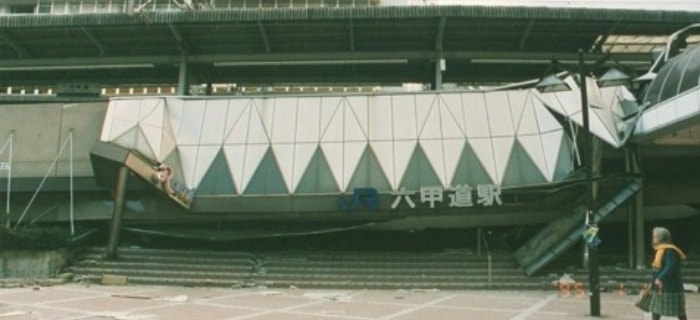
|
1990 |
1990 |
1991 Hiroshima new transportation system bridge girder drop |
1992 |
1993 
Rainbow Bridge opened |
1994 |
1995 |
1996 |
1997 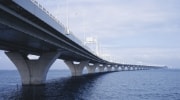
Aqua-Line Expressway opened |
1998 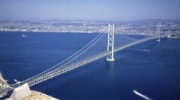
Akashi-Kaikyo Bridge opened |
1999 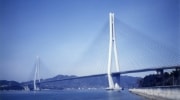
Shimanami Expressway opened (Tatara Bridge opened) |
|
Tateshina recreational facility, Tateshina Villa renovated. Established Himawari Co., Ltd. in Ichihara-shi, Chiba (renamed Miyaji Technical Industry Co., Ltd. in June 1993). |
The second round of warrant bonds issued. |
Large (component manufacturing) plant completed. Miyaji Steeltech Co., Ltd. established, Himawari Co., Ltd. renamed Miyaji Technical Industry Co., Ltd. President Toyama appointed Executive Director of the Japan Bridge Association |
The third round of warrant bonds issued. |
Miyaji Comprehensive Maintenance Co., Ltd. established in Chiyoda-ku, Tokyo, through joint funding by MIYAJI IRON WORKS CO., LTD. and MIYAJI CONSTRUCTION & ENGINEERING CO., LTD. The fourth round of warrant bonds issued. |
Marked 50th anniversary of Matsumoto Works. Marked 50th anniversary of MIYAJI labor union. |
Chiba Works obtained ISO 9001 quality management system certification. |
MIC Co., Ltd. established in Ichihara-shi, Chiba (merged with and absorbed by Miyaji Technical Industry Co., Ltd. (now MG Corporation Inc.) in July 2015). MIYAJI ENGINEERING CO., LTD. established in Ichihara-shi, Chiba |
Maintenance departments integrated. |
||
|
Kyushu Branch opened (now Fukuoka Sales Office). |
||||||||||
|
Yokohama Office and Hiroshima Office obtained ISO 9001 quality management system certification. |
||||||||||
2000
2003 Establishment of MIYAJI ENGINEERING GROUP
2007 Sale of Head Office building
Niigata Chuetsu Earthquake
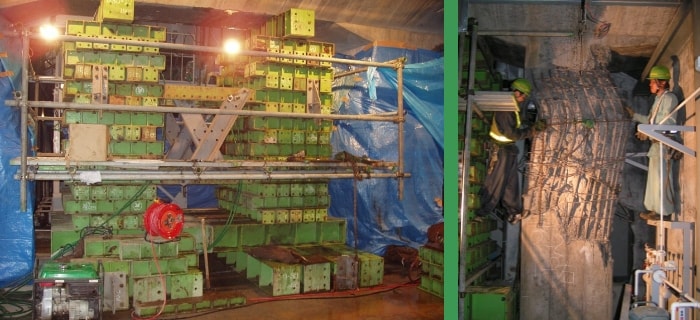
|
2000 |
2000 |
2001 Public project budget reduced by the First Koizumi Cabinet. |
2002 |
2003 Establishment of MIYAJI ENGINEERING GROUP  |
2004 |
2005 Act on Promoting Quality Assurance in Public Works enacted MHI Construction changed its name to MHI Bridge Engineering and took over the bridge and coastal structures business from Mitusbishi Heavy Industries through an absorption-type demerger. |
2006 |
2007 Sale of Head Office building |
2008 September 2008: Global financial crisis |
2009 The Democratic Party of Japan administration “People, not concrete” policy of restrained public sector construction 
Hiroshima Airport Bridge opened |
|
<Establishment of MIYAJI ENGINEERING GROUP> Became the first holding company in the industry, listed on the 1st Section of the Tokyo Stock Exchange. In order to respond to the sudden reduction in public sector investment, MIYAJI IRON WORKS CO., LTD. and MIYAJI CONSTRUCTION & ENGINEERING CO., LTD. were merged. |
||||||||||
|
Head Office relocated to newly purchased building in Odenma-cho, Chuo-ku, Tokyo. |
Omiya Equipment Warehouse closed. |
Miyaji Comprehensive Maintenance Co., Ltd. transferred to MIYAJI CONSTRUCTION & ENGINEERING CO., LTD. MIYAJI IRON WORKS CO., LTD. Matsumoto Branch established. |
Concluded technical partnership agreement with Komai Tekko Inc. |
Japan Fair Trade Commission complained. |
66 employees voluntarily resigned. |
Sold investment securities (three stocks, sale amount: \1,285 million). |
Marked 100th anniversary of company’s foundation. Wholly-owned subsidiary Kumagai Kensetu Kogyo Co., Ltd. dissolved. |
|||
|
Purchased additional shares of Miyaji Comprehensive Maintenance Co., Ltd., converting it into a wholly-owned subsidiary. Carried out absorption-type merger with Miyaji Comprehensive Maintenance Co., Ltd. Head Office relocated to Chuo-ku, Tokyo. |
38 employees voluntarily resigned. |
|||||||||
|
Obtained ISO 9001 quality management system certification for entire company. |
Continued doing business with the absorption-type split of Mitsubishi Heavy Industries, Ltd.’s bridge and coastal structure business. Name changed to Mitsubishi Heavy Industries Bridge Engineering Co., Ltd. |
Name changed to Mitsubishi Heavy Industries Bridge & Steel Structures Engineering Co., Ltd. |
Chiba Works constructed in Futtsu-shi, Chiba, and began temporary operation. |
|||||||
|
Bridge and coastal structure business transferred to Mitsubishi Heavy Industries Bridge Engineering Co., Ltd. through absorption-type split. |
2010
2010 Matsumoto Works closed
2011 MIYAJI IRON WORKS and MIYAJI CONSTRUCTION & ENGINEERING
merge. Name of merged company changed to MIYAJI ENGINEERING
2015 MM BRIDGE brought into the Group
Great East Japan Earthquake
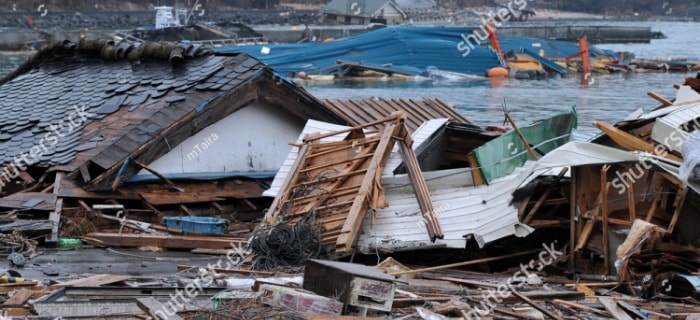
|
2010 |
2010 Matsumoto Works closed |
2011 MIYAJI IRON WORKS and MIYAJI CONSTRUCTION & ENGINEERING merge. Name of merged company changed to MIYAJI ENGINEERING |
2012 
Tokyo Gate Bridge opened Tokyo Skytree completed MEG's adbanced technical capabilities are also playing an active role in the construction of the technically challenging Tokyo Sky Tree. 
|
2013 |
2014/p> |
2015 MM BRIDGE brought into the Group |
2016 |
2017 |
2018 |
2019 |
|
Acquired shares of Miyaji Technical Industry Co., Ltd. (now non-consolidated subsidiary MG Corporation Inc.) and converted it into a wholly-owned subsidiary. |
<MM BRIDGE brought into the Group> Outside Director system introduced. |
Conducted share consolidation (10 to 1 consolidation). |
||||||||
|
Dissolved wholly-owned subsidiary MIYAJI IRON WORKS CO., LTD. Matsumoto Branch and Alps Technical Industry Co., Ltd. |
Transferred all shares of Miyaji Technical Industry Co., Ltd. to MIYAJI ENGINEERING GROUP, INC. 41 employees voluntarily resigned. <MIYAJI IRON WORKS and MIYAJI CONSTRUCTION & ENGINEERING merge. Name of merged company changed to MIYAJI ENGINEERING> |
Solar power generation business launched in order to effectively utilize site of former Matsumoto Works, which was closed in 2010 when Matsumoto Power Plant began operations, and to engage in environmental business. |
Constructed MIYAJI ENGINEERING Matsumoto Power Plant in Matsumoto-shi, Nagano, and began power generation business. |
Carried out absorption-type merger with MIYAJI CONSTRUCTION CO., LTD. |
Chiba Works buildings and facilities partially damaged by Typhoon Faxai. |
|||||
|
Established MK WORKS CO., LTD. in Kurihashi-machi, Kitakatsushika-gun, Saitama (now a non-consolidated subsidiary). |
Absorption-type merger with MIYAJI IRON WORKS CO., LTD. Company name changed to MIYAJI ENGINEERING CO., LTD. (now a consolidated subsidiary). |
|||||||||
|
Chiba Works buildings and facilities partially damaged by Typhoon Faxai. |
Chiba Works began full-fledged operation. |
Hiroshima Plant closed. |
Name changed to MM BRIDGE CO., LTD. Hiroshima Head Office relocated (from Mitsubishi Heavy Industries, Ltd. Hiroshima Machinery Works Eba Plant to Ryoko Center Building). |
Ichihara Works opened. Toyama Branch opened. |
Nagasaki Branch opened. |
|||||
|
51% of shares of Mitsubishi Heavy Industries Bridge & Steel Structures Engineering Co., Ltd. transferred to MIYAJI ENGINEERING GROUP, INC. |
2020
Kanae Ohashi
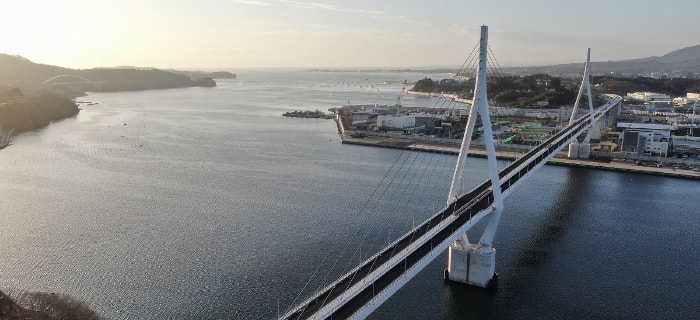
|
2020 |
2020 |
2021 
Opening of the Ariake Chikugo River Bridge 
Opening of the Kanae Ohashi (Kesennuma Bay Crossing Bridge) |
2022 Moved from the First Section of the Tokyo Stock Exchange to the Prime Market |
2024 Medium-Term Business Plan Announced |
||
|
Company format changed to a Company with an Audit and Supervisory Committee. |
Transferred from Tokyo Stock Exchange 1st Section to Prime Market. |
|||||
|
Chiba Works renovation project |
||||||
|
Kansai Branch Office renamed the West Japan Branch. |
Nasu Equipment Center transferred from Mitsubishi Heavy Industries Machinery Systems, Ltd. |

MIYAJI IRON WORKS began operations
Eijiro Miyaji opened sole proprietorship in Minami-Futaba-cho, Honjo-ku, Tokyo. Began manufacturing bolts, iron doors, and similar products, and accepting orders for steel framework assembly.
Matsumoto Works (Hata Works) opened

Works burned down in Tokyo Air Raid. Part of plant operations relocated to Hata Village in Nagano on request from the Imperial Japanese Navy Technical Department, establishing the Hata Works (Matsumoto Works) (operations shut down completely in December 2014).
MIYAJI CONSTRUCTION & ENGINEERING spun off as independent company

The civil construction department of MIYAJI IRON WORKS split off and MIYAJI CONSTRUCTION & ENGINEERING CO., LTD. established in Chuo-ku, Tokyo.
Suna-machi No. 1, No. 2, and No. 3 Works completed

Suna-machi No. 1 and No. 2 Works completed.
Suna-machi No. 2 Works expanded and No. 3 Works completed.



